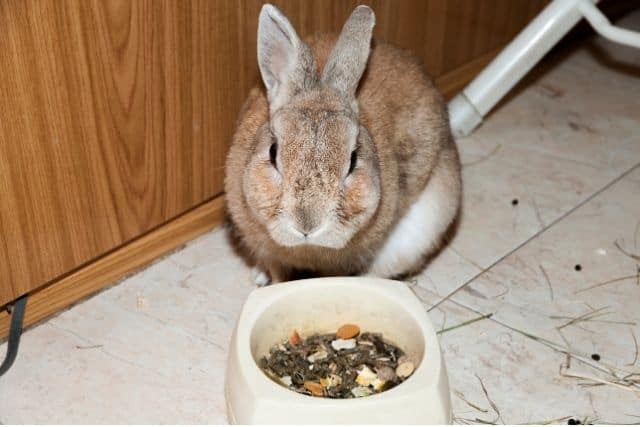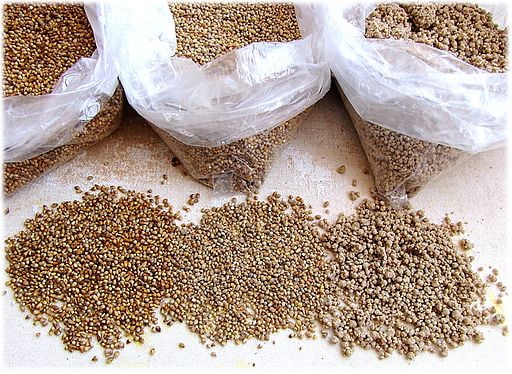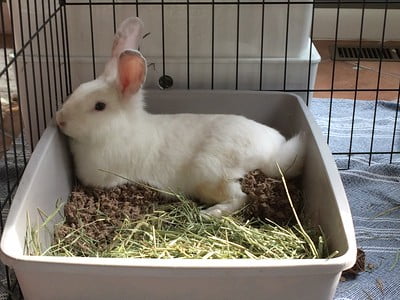Last Updated on February 28, 2023 by Marjon Ramos
If your rabbit is 7 weeks to 7 months old, feed them unlimited pellets for optimal growth. While 7-months to 1-year-old rabbits should decrease the consumption of pellets to 1/2 cup per 6 pounds of body weight.
For rabbits that are 1–5 years old, you can decrease the amount to 1/4 to 1/2 cup per 6 lbs of body weight. Given that your rabbit’s weight is within the normal range.
Finally, you can feed your senior rabbit (> 6 years old) 1/4 cup per 6 pounds of body weight if they are not obese.
Now that I’ve given you the gist of the article, read on as I explain in more detail the proper portion of pellets to feed your rabbits:
Table of Contents
How much pellets should you feed a rabbit?

Pellets should only account for 5% of your rabbit’s diet. While it’s true that pellets are great for rabbits, overfeeding them would do more harm than good.
When deciding the amount of pellets to feed our rabbits, we must do so with the goal of not causing any health problems. Always consider these variables to prevent such health problems:
Age
The age of your rabbit is the most important factor when deciding how much to feed them. The general rule is that the older the rabbit, the fewer pellets they need.
Older rabbits are more prone to obesity. Most pellet brands are high in carbs, so overfeeding them to older rabbits can lead to obesity.
Here’s a table to guide you on how much pellet you should feed your rabbits as they get older.
| Age | Pellets |
|---|---|
| 7 weeks to 7 months | Unlimited |
| 12 weeks | Unlimited |
| 7 months to 1 year | Decrease amount fed to ½ cup per 6 lbs (2.7 kg) BW |
| Adult (1-5 y) | ¼ to ½ cup per 6 lbs (2.7 kg) BW |
| Seniors (>6 y) | Continue adult diet if weight is okay; frail, older rabbits may fed unlimited pellets |
Breed
Another factor to consider is the size of your rabbit. As a general rule, the larger the breed, the more pellets they need to consume.
Here’s a guide to help you determine how much pellets to feed your bunnies.
| Small Breeds | Medium Breeds | Large Breeds |
|---|---|---|
| •2-3 ounces of pellets per day | 3 ½ – 4 ounces of pellets per day | 4 – 8 ounces of pellets per day |
Pellet quality
The quality of the pellets you feed your rabbit is also an important factor. Low-quality pellets from untrusted brands often contain a lot of carbs. It’s also often not a standardized formula, which means there are not enough nutrients.
The whole point of feeding pellets to rabbits is to get the nutrients they need for long-term health. Feeding your rabbit a non-standardized formula would likely do more harm than good.
Never cheap out on your rabbit’s pellets. Don’t worry too much about the cost; pellets should only make up 5–10% of your rabbit’s diet anyway.
Always read the label when buying pellets for your rabbit. Make sure that it meets the criteria of the American Rabbit Breeders Association:
| Fiber | Fat | Calcium | Protein |
|---|---|---|---|
| •12% to 22% •Not less than 18% | •3% or less | •Less than 1% | •14%-18% |
Can rabbits overeat pellets?

Yes, rabbits can overeat pellets. While this is not much of a concern for younger rabbits because they can eat a lot of pellets for optimal growth.
Overfeeding pellets to older, obese rabbits is where it starts to become a problem. Low-quality pellets are high in carbs and low in fiber.
Older rabbits already have a slower metabolism compared to young rabbits. Feeding them a diet that’s high in carbs can increase the risk of obesity.
Feeding a high-carb diet to rabbits can lead to all kinds of health problems. Digestive problems like diarrhea, GI stasis, and uneaten cecotrophy are the most common.
Risk of overfeeding pellets to rabbits.

Pellets are essential for your rabbit’s long-term health. Without pellets, you would need to feed your rabbit with the right mixture of vegetables on a daily basis.
But that doesn’t mean you can feed it to your rabbit without supervision. Here are the most common problems associated with overfeeding pellets to rabbits:
Obesity
Because of their slower metabolism, older rabbits are more prone to obesity. That is why you should limit the amount of pellets you feed your older rabbits because the majority of them are high in carbs.
Obesity in rabbits can lead to all kinds of health problems. The most common health issues obese rabbits can experience are myiasis, pregnancy toxemia, and GI stasis.
Obese rabbits would also find it hard to clean themselves under their skin folds because of all the fat. If the skin goes unclean for a long enough time, it could lead to dermatitis.
Finally, obese rabbits could also experience difficulty breathing and lower energy levels.
Diarrhea
Diarrhea in rabbits is often caused when a sudden shift in their diet happens. If all of a sudden, you overfeed pellets to rabbits, it could lead to an imbalance in their gut flora.
If you want to know if your rabbit has diarrhea, look at its butt. Rabbits with diarrhea often have what’s called a “poopy butt”.
But “poopy butt” could also be uneaten cecotropes. which is less of an emergency compared to diarrhea. To tell the difference, look at their litter box and check if there are any solid poop pellets in there.
Rabbits with diarrhea would not produce solid poop pellets. While soft, uneaten cecotropes would still produce solid poop pellets.
Gastrointestinal stasis
Low-fiber, high-carb diets are the main causes of GI stasis. Overfeeding pellets can lead to GI stasis because pellets are low in fiber. Most non-stardardized pellets from non-reputable brands are also high in carbs.
If you notice any of these symptoms of GI stasis, bring your rabbit to a veterinarian:
- Depressed
- Hunched posture
- Bruxism
- Decreased appetite/anorexia
Conclusion
You should base your rabbit’s pellet portions on their age and weight. Young rabbits (seven weeks to seven months old) should have access to unlimited amounts of hay for optimal growth.
You should base your rabbit’s pellet portions on their age and weight. Young rabbits (seven weeks to seven months old) should have access to unlimited amounts of hay for optimal growth.
While 7-months-to-1-year-old rabbits should eat 1/2 cup of pellets per 6 pounds of body weight.
Older rabbits could skip pellets altogether if they are obese. Otherwise, you can feed older rabbits 1/4 cup of pellets per 6 pounds of body weight.
Cite this article:
Sources and further reading
- Buseth, Marit Emilie., and Richard A. Saunders. Rabbit Behaviour, Health, and Care. CABI, 2014.
- Lebas, F. The Rabbit: Husbandry, Health, and Production. Food and Agriculture Organization of the United Nations, 1997.
- Patry, Karen, et al. The Rabbit-Raising Problem Solver: Your Questions Answered about Housing, Feeding, Behavior, Health Care, Breeding, and Kindling. Storey Publishing, 2014.
- Understanding the Basics of Rabbit Care
- Basic-Rabbit-Care




